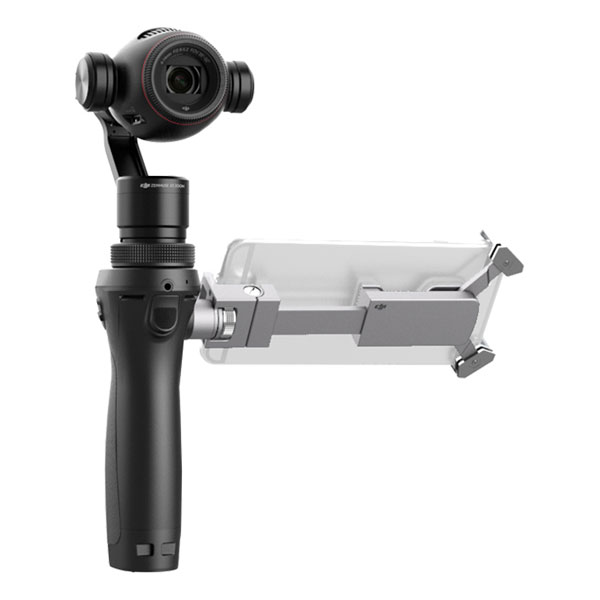Gimbal-stabilized DJI Osmo+ camera boasts a brand-new zoom lens; original Osmo gets a handy price cut
posted Tuesday, August 30, 2016 at 7:59 AM EDT

Last October, drone maker DJI branched out in a new direction with its Osmo, a clever gadget that coupled the gimbal camera platform used in its unmanned aerial vehicles with an ergonomic pistol grip. The result was billed as an action camera with a difference: The ability to shoot really well-stabilized video, yet with intuitive control over camera aiming. Now, the company has followed up surprisingly quickly with the DJI Osmo+, an update which gifts its earlier design with one very important new feature.
Those of you with a knack for reading between the lines may well have seen this coming. Last month, DJI launched a new camera for its drones complete with true optical zoom capability, the Zenmuse Z3. The obvious and immediate question was whether this new creation could be used with the existing Osmo grip, since the Osmo's cameras were shared with those on the drones. The answer was an equally-swift no, but it was a no-brainer that such a device would be on the way, given DJI's history of repurposing hardware for multiple different products.
And now that device is here, with the launch of the Osmo+. It seems that the original Osmo couldn't be retrofitted to support zoom control, and that tweaks to the hardware were required -- both to the grip, and also to the camera and gimbal. We say that because not only is the Osmo+ a separate and distinct model from the original Osmo, but the Zenmuse X3 camera it uses is also not compatible with drones capable of using the Z3 camera.

There's no question that the similarities between the Z3 and X3 cameras are striking, though. Both use the same 22-77mm equivalent, 3.5x optical zoom lens, and both are based around a 12.4-megapixel Sony Exmor R CMOS image sensor. (By way of comparison, the original Osmo camera was also based around the same sensor, but with a 20mm-equivalent fixed focal length.) And they share the same sensitivity range of ISO 100 to 3200-equivalents (ISO 1600 max. for stills) as well, along with the same eight to 1/8,000-second shutter speed range. Other shared features include 4K video capture at either 24, 25 or 30 frames per second, with the fastest rate only available with a slight horizontal crop from the default 4,096 x 2,160 pixels to 3,840 x 2,160.
The differences between the cameras are few and far between. DJI's marketing materials suggest that the X3 variant of the camera can shoot 100 fps video at Full HD resolution, where the Z3 camera for drone use is limited to 60 fps max. And the Osmo+ version of the camera also has a rated focus range of 1.6 feet to infinity, where specs for the drone-friendly variant don't mention focusing distances. (And if we had to guess, this is likely the biggest distance between the two cameras. The Osmo+ has to be able to focus pretty close for selfie shooting, whereas the drone camera is never likely to need to focus on a subject just a foot or two away. Quite likely, the difference in focus range is the most significant point of variance between the two cameras, although there may well be other differences.)

In most respects, the Osmo+ meanwhile is also very similar to its predecessor. Beyond the ability to provide a 3.5x optical zoom -- which can be coupled with a lossless 2x digital crop for an effective 7x zoom at Full HD resolution -- there are only a few obvious differences between the two. For one thing, the aforementioned 100 fps maximum video framerate in Full HD capture for the Osmo+ is a little slower than the 120 fps provided on the earlier Osmo.
But at the same time, the new camera -- like the Zenmuse Z3 before it -- provides for 2.7K capture, where the original Osmo didn't offer anything between its 4K and Full HD resolutions. And one other particularly noteworthy change is a new Motion Timelapse function which will let you specify start and end points, then smoothly pan the camera during timelapse capture. DJI also says that stabilization has been further improved on the new model, and notes the new inclusion of a Flexi Microphone in the product bundle.

Available immediately, the DJI Osmo+ with its X3 camera is priced at US$650 or thereabouts, the same point at which the original Osmo went on sale almost a year ago. And if you don't need the zoom capability, the original Osmo can now be purchased for $570, again with the Flexi Microphone now included in the product bundle. Given that the microphone itself lists for $10, that makes the new price for the original Osmo a savings of some $90 (14%) over its list price on day one last October.
More details on the Osmo+ can be found on DJI's website.